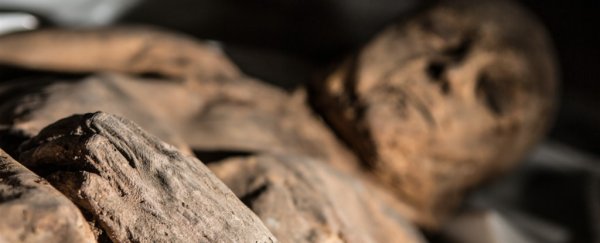An international team of researchers might be on the cusp of understanding where smallpox originated, after finding one of the earliest known samples of it in the DNA of a mummified child who lived in the 17th century.
If verified, the discovery could rewrite our current, patchy understanding of the virus's origins, and suggest that the disease arose thousands of years later than originally thought.
While smallpox was eradicated in the 1970s, researchers know surprisingly little about how it first spread to humans, and when it became so virulent. They hope to uncover more about the virus's history by analysing of the remains of the child, which were found inside a church's crypt in Lithuania.
"Scientists don't yet fully comprehend where smallpox came from and when it jumped into humans," said senior author Hendrik Poinar, from McMaster University in Canada. "This research raises some interesting possibilities about our perception and age of the disease."
The discovery of smallpox in the remains was actually an accident. The team was investigating the remains – which likely belonged to a boy – to identify the kinds of pathogens that were around back in the 1600s.
To their surprise, they found evidence of smallpox, despite the fact that the child showed no signs of the disease, reports Nell Greenfieldboyce at NPR.
Despite not showing any outward symptoms, like pock marks, the team was able to completely reconstruct the disease's genome, providing one of the oldest completed genomes of it in existence.
Then, they compared this genome to samples of the disease taken in the 1940s, right up to its eradication in the 1970s.
In doing so, the team was able to create an evolutionary map of the disease. They found that all of the strains currently available for study have a common ancestor that lived in the 1500s. What happened before that – such as how the disease jumped from a different animal to humans – is still unknown.
In the past, research had suggested that people in ancient Egypt might have had smallpox around 3,000 to 4,000 years ago - but this is based on pockmark scarring on mummies, and not the presence of the virus itself.
The new find suggests that smallpox is actually a lot more recent, and seems to have started plaguing humans during the time of worldwide exploration in the 1500s.
"This study sets the clock of smallpox evolution to a much more recent time-scale," said team member Eddie Holmes, from the University of Sydney, Australia.
"Although it is still unclear what animal is the true reservoir of smallpox virus and when the virus first jumped into humans."
The study also indicates that much of the history of smallpox happened rather recently in the grand scheme of things, showing that disease might have the power to spring up and evolve rather fast, infecting a large part of the world's population.
"This work blurs the line between ancient diseases and emerging infections. Much of smallpox evolution apparently happened in historic time," said team member Margaret Humphreys, from Duke University.
The team notes that understanding how the disease arose in humans is vital if we want to continue to knock out vicious diseases with vaccinations, and the only true way to fully understand a disease is to understand its origin story.
"This raises important questions about how a pathogen diversifies in the face of vaccination," explains team member Ana Duggan, from McMaster University.
"While smallpox was eradicated in human populations, we can't become lazy or apathetic about its evolution – and possible re-emergence – until we fully understand its origins."
The team's work was published in Current Biology.
